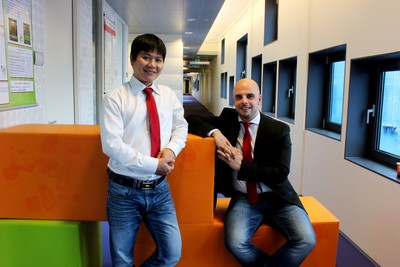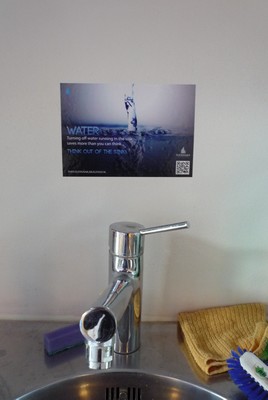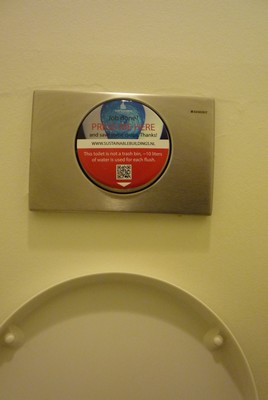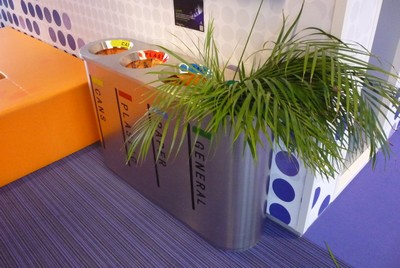Turning a blue building green
The striking blue Bernoulliborg building has been turned into a living lab, a test-bed for innovations that can save lots of energy. PhD students Faris Nizamic and Tuan Anh Nguyen have used their 2012 Green Mind Award to experiment with various ways to make the building more sustainable.

Water-saving devices on all taps, a smart sensor system to reduce lighting in the canteen when nobody is there, new bins to separate waste at source and sleep timers on all PCs – staff and students have seen quite some changes in the Bernoulliborg, all thanks to Faris Nizamic (Bosnia-Herzegovina) and Tuan Anh Nguyen (Vietnam).
Both are working on their PhD theses in the Department of Computer Science on the fifth floor of the Bernoulliborg. This is home to Professor Marco Aiello ’s group , which is working on several projects that use computer technology to increase the energy efficiency of homes and offices.
In 2012, Nizamic and Nguyen’s PhD projects suddenly increased in size when their plan to make the Bernoulliborg more sustainable won them the first University of Groningen Green Mind Award . The EUR 100,000 prize money has enabled them to realize the project and now, some two years later, they can give an overview of the results.

‘The kick-off meeting was in May 2013, so that’s when things really got started’, says Faris. It turned out to be a change from their usual routine. ‘We had to substantially improve our skills’, says Tuan. ‘Like planning, organizing meetings and project management.’ It is one thing to say you are going to reduce electricity and water consumption, but it is quite another to install the necessary components in a real building.
Faris: ‘We installed new meters to measure electricity and water use in specific locations.’ This necessitated numerous meetings with the facility managers and other staff, and resulted in water-reducing devices being fitted on all taps in the building, and stickers being put up in coffee corners and toilets encouraging people to save water. They used the water meters see if this had an effect.
Another very visible change was the removal of all general waste bins from the offices. These were replaced by bigger, central bins for the separate collection of cans, plastic, paper and general waste. ‘This was an experiment in changing people’s behaviour’, says Faris. ‘We held a survey to see how staff adapted to the new system.’

The survey was designed by the research group of social psychologist Professor Linda Steg from the Faculty of Behavioural and Social Sciences. The survey showed that this new policy could increase recycling rates in University buildings. Furthermore, people who had encountered this policy in their own building found it more acceptable than people who had not yet encountered it. Overall, the participants rated the policy as reasonably acceptable.
There are of course limits to what two people can do. As Tuan says, ‘We could save even more water by replacing the toilets with water-saving ones, but that was clearly not feasible within the scope of the project.’ And if you want to recycle more waste, you need to buy goods that are easily recyclable, which is also not in the hands of Faris and Tuan. ‘But our results can be used for future management decisions, and in planning new buildings like Zernikeborg.’
Other measures could be taken without much fuss. As Faris explains, ‘We have installed sensors in the canteen, which is open twelve hours per day but only used for around three. The sensors reduce lighting when nobody is there or when the level of natural light is sufficient.’ This could easily save some 5,000 kWh per year, which is more than the electricity consumption of the average Dutch household, all without changing the lights or switching to LED lights.
Other savings were made by changing the sensors in the offices. ‘The old sensors turned off the lights if they hadn’t detected movement for 45 minutes’, explains Faris. With the new sensor holders the sensors have a better field of view, so the risk of turning off the lights when someone is working there has been reduced. ‘So we can set them to turn off the light after just 10 to 20 minutes without movement.’

They are now implementing the last part of the project, a programme to switch computers to sleep mode after a period of inactivity. Faris: ‘Sleep mode was disabled, because the CIT computer centre needed to be able to install updates when necessary, and with the current implementation that could not be done in sleep mode. The new sleep programme allows them to install updates even if PCs are in sleep mode.’ It is estimated that this will save at least EUR 5 per PC per month. Faris shows the energy consumption of his own PC with and without sleep mode: a saving of EUR 10 per month. ‘But that’s because I work with two screens.’
Meanwhile, the pair also won second prize in the second Green Mind Award earlier this year. They now want to implement some of the changes tested in the Bernoulliborg in the Heymans Building, which accommodates the Faculty of Behavioural and Social Sciences. ‘It’s an older building, which means we can also regulate the radiators that heat the rooms’, says Tuan.

Aren’t all these activities and new plans getting in the way of their PhD theses? Both smile. Yes and no. They have published some of the results and can thus use them in their theses. And the project is closely related to their original plans (testing highly distributed systems – energy-smart buildings for Faris and wireless-sensor networks and activity recognition in smart environments for Tuan).
All the sensors they and other members of their group have installed also make a great living lab: ‘In addition to what we’ve done, fifteen offices and a coffee corner have sensors’, Faris says. ‘We can measure all sorts of details in a real working environment, which is fairly unique.’ Tuan: ‘These kinds of real measurements are often lacking in scientific papers.’ In contrast, they have plenty. Besides which, students love to work on related projects in their placements and Master’s theses, which makes the lab a great addition to the curriculum.
Tuan expects to defend his thesis in a few months, and Faris will follow. And after that? ‘We are looking at the options of starting a commercial spin-off’, says Faris. The energy-saving programme will continue at the University of Groningen, with the support of the Faculty, the University Research & Valorization Office and the Board of the University.
| Last modified: | 28 September 2020 4.15 p.m. |
More news
-
16 April 2024
UG signs Barcelona Declaration on Open Research Information
In a significant stride toward advancing responsible research assessment and open science, the University of Groningen has officially signed the Barcelona Declaration on Open Research Information.
-
02 April 2024
Flying on wood dust
Every two weeks, UG Makers puts the spotlight on a researcher who has created something tangible, ranging from homemade measuring equipment for academic research to small or larger products that can change our daily lives. That is how UG...
-
18 March 2024
VentureLab North helps researchers to develop succesful startups
It has happened to many researchers. While working, you suddenly ask yourself: would this not be incredibly useful for people outside of my own research discipline? There are many ways to share the results of your research. For example, think of a...

